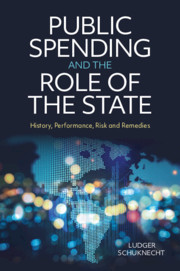Book contents
- Public Spending and the Role of the State
- Public Spending and the Role of the State
- Copyright page
- Dedication
- Contents
- Figures
- Tables
- Preface
- Acknowledgements
- Acronyms and Abbreviations
- Introduction
- Part I The Growth of Government
- Part II Value for Money
- Part III Fiscal Risks
- Part IV Remedies
- 10 Rules and Institutions
- 11 Conclusions and Epilogue
- Table of Data Sources
- Bibliography
- Index
10 - Rules and Institutions
from Part IV - Remedies
Published online by Cambridge University Press: 30 October 2020
- Public Spending and the Role of the State
- Public Spending and the Role of the State
- Copyright page
- Dedication
- Contents
- Figures
- Tables
- Preface
- Acknowledgements
- Acronyms and Abbreviations
- Introduction
- Part I The Growth of Government
- Part II Value for Money
- Part III Fiscal Risks
- Part IV Remedies
- 10 Rules and Institutions
- 11 Conclusions and Epilogue
- Table of Data Sources
- Bibliography
- Index
Summary
Rules and institutions are at the heart of effective and well-managed governments that focus on their core tasks. Sound rules and institutions constrain policy-makers and guide the expectations of citizens. This promotes trust, opportunities, prosperity and freedom. It prevents hubris and excessive expectations about what governments should and can do. Sound rules and institutions constrain deficits, spending and debt. They govern the process of budget-making and implementation and ensure the effectiveness and efficiency of spending programmes. They also help constrain government activities relative to the private sector. Rules and institutions for the banking and shadow banking sectors protect government and citizens from the fiscal risks of financial crisis. The international institutional architecture underpins stability across both countries and continents. Fiscal rules and institutions have gone through phases of support and decline, and there has been more progress in the financial than in the fiscal sphere. We need to re-strengthen our rules and institutions to tackle successfully the challenges of the ‘spending state’: to keep government lean, efficient and sustainable.
Keywords
- Type
- Chapter
- Information
- Public Spending and the Role of the StateHistory, Performance, Risk and Remedies, pp. 235 - 256Publisher: Cambridge University PressPrint publication year: 2020



